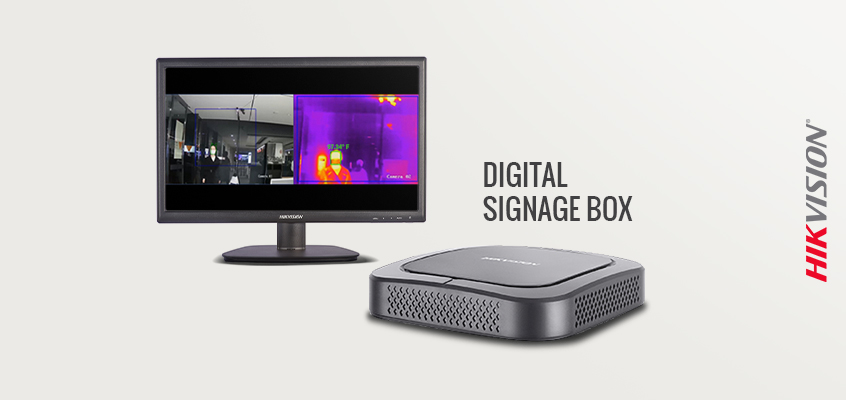Nouvelle boîte de signalisation numérique Hikvision : transmission des données numériques, vidéo et audio

Le nouveau boîtier d’affichage numérique DS-D60C-B de Hikvision transmet des contenus numériques, vidéo, audio et d’autres types à un moniteur ou à un affichage numérique. Il fournit également une planification de programme flexible qui permet l'affichage de différents types d’équipements sur un horaire personnalisé.
Répondant aux besoins actuels de distanciation sociale et de sécurité des clients, l'appareil peut afficher des informations importantes fournies par les produits Hikvision, telles que :
- Comptage de personnes : affiche le nombre de personnes à l’intérieur et combien de personnes peuvent encore entrer, en plus de fournir des alertes lorsque le nombre maximum de personnes est détecté pour respecter les critères de distanciation sociale.
- Détection de masque : lorsqu'un client sans masque est détecté, une notification personnalisée apparaît.
- Dépistage de la température : la lecture de la température est affichée grâce au terminal de détection de la température.
De plus, des informations telles que des images publicitaires ou des vidéos peuvent être affichées en boucle. Le logiciel gratuit FocSign Lite pour configurer et gérer votre (vos) écran(s) est fourni avec le boîtier de signalisation numérique. Le logiciel FocSign Lite peut prendre en charge jusqu'à 50 canaux d'affichage numérique.
Le boîtier de signalisation numérique DS-D60C-B offre des fonctions de sécurité telles que :
- Vérification à trois niveaux des matériaux
- Programmes et horaires pour éviter les versions incorrectes
- Chiffrement du stockage et de la transmission des données pour empêcher la falsification des données et affichage des résultats de température sur un écran de surveillance local pour une identification rapide
Le produit propose des autorisations utilisateur à plusieurs niveaux et des fonctionnalités d'organisation qui permettent de gérer les matériaux, les programmes, les terminaux et les utilisateurs à partir d'un emplacement centralisé.
Il prend également en charge :
- Matériaux statiques et dynamiques, y compris les applications, les images, l'audio, la vidéo, les PDF, les médias en continu, les pages Internet, la vidéo en direct, les données de tiers, etc.
- Modes d'affichage variables, tels que l'affichage par jour ou par semaine et l'affichage personnalisé, etc. Contrôle et gestion à distance d'un ou plusieurs écrans, y compris le démarrage / arrêt chronométré, luminosité / volume chronométré et aperçu de la capture d'écran.
- Organisation à cinq niveaux pour la gestion des matériaux, programmes, terminaux et utilisateurs.
- Création d'utilisateurs personnalisés et attribution des permissions des utilisateurs en fonction des autorisations.
- Télécommande et communication sans fil 433 MHz qui permet de contrôler le boîtier de distribution d'informations dans n'importe quelle direction.
Contactez votre représentant Hikvision dès aujourd'hui pour en savoir plus, ou visitez la page du produit en ligne
